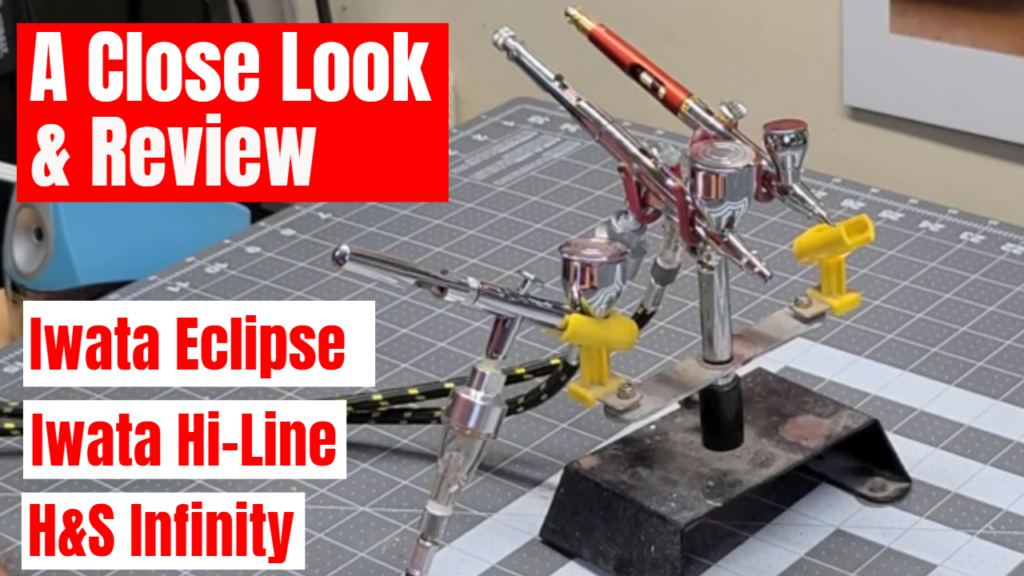Airbrush Review - Eclipse, Hi-Line & Infinity
I have owned an Iwata Eclipse (manufactured in Japan) for about 20 years, my first airbrush was a siphon feed Paasche. Once I switched to a gravity fed brush I never looked back. Now that’s not to say siphon’s aren’t any good, they are, it just depends on what kind of art you want to do and what you are trying to achieve. For example, if you want to do T-Shirts, siphon is the way to go, if you are looking for fine detail, like in illustration or photo realism, then gravity fed brushes will suite you better. With that said, lets take a closer look and review of the Iwata Eclipse hp-cs, Iwata hi-line hp-ch and the Harder & Steenbeck Infinity Cr-Plus. Starting with the Eclipse, it is a middle of the road brush that has a .35 needle nozzle. It is a straight up airbrush with no added features, such as MAC valve or trigger stop. Most people who own an Eclipse call it their “workhorse”, it is capable of giving you a broad line to a nice fine line. I really like this brush for learning and beyond, I like it for learning for a few reasons, you can’t rely on a trigger stop, you have to rely on you trigger control, developing you finger mussel memory is crucial. With the .35 needle nozzle you shouldn’t have much trouble with paint flow at a 20 to 30% reducer mix. I also really like the nozzle, it is big and easy to handle during cleaning and has no threads, it seals by compression. When you screw on the nozzle cap it compresses the nozzle into a tapered hole and that creates the seal. The price point on this brush is $150 to $180.
Now, lets talk about the Iwata Hi-line (manufactured in Japan). It sports a .30 needle nozzle combination, so similar to the Eclipse, but this brush has a couple added features and the nozzle is not the same. The nozzle has threads and is very small, similar to it’s upper end brother (and much more expensive) the Iwata Micron, so much care needs to be taken when cleaning and tightening the nozzle. The threads are very fine and delicate and could be damage if over tightened, once you get the hang of it though, it’s not a problem. It has a MAC Valve (Micro Air Control) which allows you to control the air pressure right on the brush (instead of at the compressor) this is a nice feature when performing certain techniques. Last, it has a trigger stop. This allows you to set the trigger at a certain distance to allow a consistent paint flow. The stop is set by turning the handle, you need to pull the trigger, allowing full paint flow and then turn the handle until it pushes the trigger towards the front of the brush (less paint flow) until you are satisfied with the flow rate of paint. There is no numbers or dial to remember where the stop was set if you wanted to go back to it later. The price point on this brush is around $230.
Last, is the Harder & Steenbeck Infinity CR Plus. This brush is German engineered, it is still manufactured in Germany, but in 2017, Iwata bought the company. It is available with a .2 or a .18 needle nozzle combination. It also can be bought as a two in one combination and it come’s with a .2 and a .4 needle nozzle combination and two color cups, one small and one large. I will be focusing on the .18/.2 version. It is smaller and lighter than the Iwata’s and feels really good in the hand. One of my favorite features about this brush is that it is tool-less! That’s right, tool-less! The nozzle is nice and big with no threads and seals by finger tightening the nozzle cap. Another cool feature is that the color cup screws on and off, which makes cleaning very easy. It has the best trigger stop, if that is something that is important to you. The handle has a button on the end of it with a number dial on it so you can remember where you had it set later. You push the button to engage and pull to disengage the stop. This is what sets it apart from other designs, this allows you to set it, use it, pull to disengage it and then when you need it again, just push the button to engage it an you are exactly set back to where you where before. This is a very nice brush and has a price point of around $320.
I hope you found this review helpful. As always…Keep airbrushing and practice, practice, practice!
Dan – “The Airbrush Garage”

